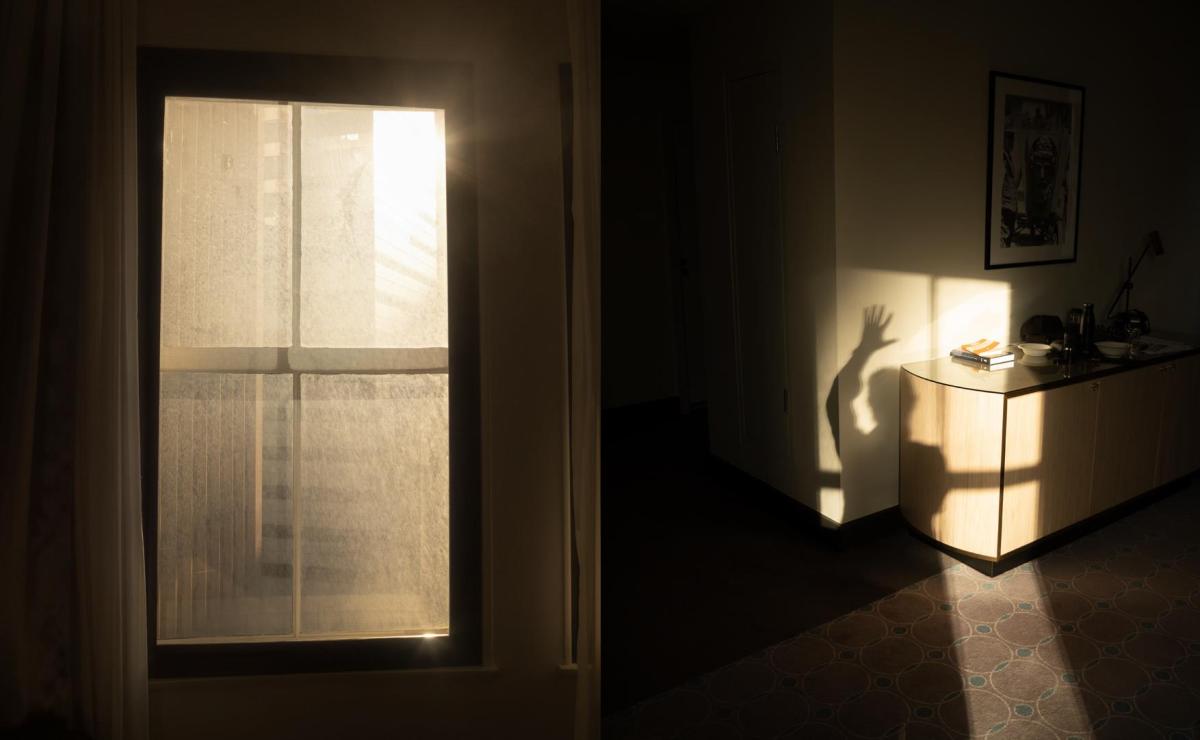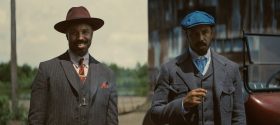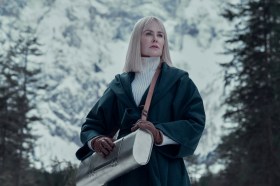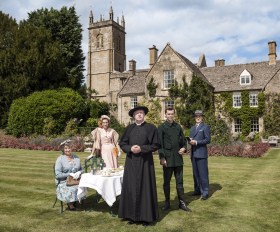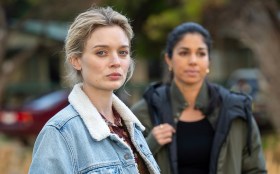Instagram has quickly become one of the easiest and most interesting ways to catch up on the movements of people working in Australian film and TV. While confidentiality clauses (and the natural desire for privacy) will limit how much is shared on this public platform, there are still many insights to be had into the projects underway, the locations being visited, and the things that fire the creativity of those within the sector.
It’s hardly surprising when those people happen to be talented photographers and gifted visual ‘content creators’ as well. This is how I came upon writer-director Glendyn Ivin’s quarantine photos, now collected and published in a book called 712.
The striking and beautiful images were taken within the confines of Ivin’s compulsory 14-day hotel quarantine. This took place in Room 712 at the Radisson Blue Plaza Hotel Sydney between 26 August and 8 September 2020. The photos include a sepia fish-eye’s view through the peephole onto an empty corridor; the intimacy of rumpled bedsheets and a solitary meal on a tray; and he radiance of sunlight slanting through windows in the late afternoon.
One of Australia’s leading directors in television drama and commercials, Ivin has long used photography as an integral part of his pre-production process, which then becomes a record of the work itself. His previous books include Secrets and Lies – a limited edition book of photos, storyboards and visual explorations from BBC1 drama The Cry; More Than a Feeling – intimate behind the scenes photos from Series 2 of Puberty Blues; and Flaming Youth, from Series 1 of Puberty Blues.
Another book seems highly likely, about the making of his second feature film, Penguin Bloom. Based on a true story and starring Naomi Watts, the film premiered earlier this year at Toronto and is due in Australian cinemas in January 2021.
Intrigued by the quarantine photos, I reached out to Ivin (by Instagram DM, as you do) to interview him about his quarantine experience, the place of photography in his practice, and his feelings about releasing a feature film into the world in these difficult theatrical times.
Rochelle Siemienowicz: Why were you there in that hotel room? Where were you coming from and where were you going?
Glendyn Ivin: I live in Melbourne and was in pre-production on a commercial when Stage 4 restrictions came into effect so we had to shut the production down. As the commercial was for an ‘essential service’ we were able to move the production to Sydney. I had the option to direct the commercial ‘remotely’ or applying for an exemption to enter NSW and go through a mandatory 14 Hotel Quarantine. To be honest ever since I had heard about Hotel Quarantine I had been fascinated by it. I had been wondering what it would be like to go into a room and not leave for two weeks. Melbourne had pretty much been in lockdown since March and strict lockdown for 4 weeks at this stage, so for me it felt like the next step. I was fascinated by the isolation and the focus that an environment could provide.
How did your experience of being in quarantine differ from expectations going in?
I researched a lot before going in. I didn’t mind the idea of doing a Quarantine, but what I didn’t like was not having any idea of what hotel I would be staying in. What would the room would be like? I became really fixated on it. I thought of the worst hotel rooms I had stayed in the past and tried to imagine being there for two weeks. I decided the best way forward was to expect the worst but prepare for the best. I read every article I could find about Hotel Quarantine. There were quite a lot of articles about people’s experiences that were super useful.
I then saw a friend of mine was posting their quarantine experience on Facebook. They were halfway through when I contacted them and they told me everything to expect. Perhaps the most useful advice was when you ‘check in’ to ask for a room upgrade. (She was in a really nice room.) Coincidentally, I ended up in the same hotel in the room above my friend. After using this advice I received the upgrade and it made a huge difference to my experience.
Was there any other advice that proved useful?
One thing I read in the lead up was to take a a list of things you have always wanted to do. Write those letters, learn that language, write that novel etc…. If you get them done in those two weeks, then that is great, but if you DON’T get through that list in those two weeks… LET THOSE THINGS GO. Get them off your mind! I thought that was pretty good advice for Quarantine and for creative lives in general!
What were your best moments and lowest times? Were you ever lonely or frustrated? What did you miss most, and was there anything you wished you had in there with you?
The best moment was perhaps on Day 3 or so when I’d crossed off a few days and I realised that this was actually going to be enjoyable. I was comfortable. I missed my family but I had everything I needed, essentially: food, internet, things to do. Despite the fact I had to work, it felt like I was on a forced holiday, and despite being unable to leave the room I felt the most free I had felt in a long time. There was a strange sense of freedom. I didn’t have to ‘be anywhere’. I only had to be exactly where I was and that was a wonderful and strangely comforting feeling.
‘I felt the most free I had felt in a long time. There was a strange sense of freedom. I didn’t have to ‘be anywhere’. I only had to be exactly where I was and that was a wonderful and strangely comforting feeling.’
I never really felt lonely. In fact during the day I was Zooming, FaceTiming and talking on the phone. I would be craving some ‘alone time’. I took in a skipping rope for exercise but wish I had some weights or a ‘walking machine’. Whenever I was on the phone I paced my room. One day I walked over 8000 steps.
At what point in the quarantine did you decide to pick up your camera, and then later create a photo book from the pictures?
I arrived in my room at about 9pm on a Tuesday night. So it wasn’t really until the next morning and I opened the curtains I could see where I was. My room was on the seventh floor and I had a couple of good views down to the street below. I noticed how the sun created these beautifully shadowed patterns on the street below. I was watching people pass through shades and light on the street below and in the distance I could see this woman wearing beautiful bright red coat walking towards one of these pockets of light. I quickly grabbed my camera and took a frame of her as she passed through the sunny pocket of light. I looked at it and was just struck by how random and beautiful it was. It was like I had been given a gift. I decided there and then that I would document my experience in the Quarantine. It would be a challenge, it would really help me embrace my situation and pass the time. The trick was always going to be: how do I find different ways to photograph the same room and the same views out of the same windows?

The woman in the red coat. Photo by Glendyn Ivin.
The photos are very beautiful and atmospheric, albeit with a sense of the constraints you were working within. Can you talk a little bit about how you made the images and what you were wanting to achieve?
I tried to embrace the constraints. I used the natural arc of the sun. I quickly noticed its path over the city and what it revealed at different times of the days. Because I was stuck in the place, if there was beautiful light on the street at a certain time of day but nothing really happening I would check back at the same time the next day to see if there was anything there. I felt like a hunter walking around checking the ’traps’ at different times of day. The photos do have an atmosphere of isolation. I was looking for images that in some way captured the experience. I was by myself and I was drawn to finding other images of isolated individuals. Slowly over the two weeks the images became more abstract. The first images I took were focused and crisp. But by the end of the images we’re more blurred and dream like. It really did feel representative of my time in Quarantine.
I was seven floors up and I only had two lenses. A 35mm and 50mm. Some of the images I had to crop quite heavily so I could get ‘closer’ to the subjects on the street.
What’s your favourite photo from the collection?
I never usually take photos of myself but there is something I like about the self portrait I took on Day 9. I was starting to lose it a bit, I really felt the walls closing in. I put the flash on the camera and took a few shots of myself in the mirror. The hard flash contrast with the blurred and hazy movement of my hands, it really captured how I was feeling. Stagnant but still the world was going on around me. From that point in my stay the photos became more ‘distorted’.

The man in the mirror. Photo by Glendyn Ivin.
You’ve made photo books before. Do you consider this as a side hustle, historical record or creative outlet? Why do you make them?
I love photography and taking photographs has become a huge part of process as a director. In pre-production I spend a lot of time searching and exploring locations and the landscapes I’m about to shoot in. Trying to find images that capture the essence of the place. Not so much the ‘look’ but more the ‘spirit’ or the ‘energy’ of the place and how I can harness that for the production. I document the cast in similar way. I spend a lot of time editing photographs in pre-production, immersing myself in the texture of the project. This continues through to shooting. I have my camera with me constantly on set. I shoot moments, I try and distil scenes and sequences into single frames. Again I think it’s about searching for and capturing the essence of what I’m making.
At the end of the project I have hundreds, thousands of images that I just don’t want to sit on a hard drive. So I started making books. The books become a diary of my experience on the project. Some of the of the images are directly related to the story, but others are more ideas, or photos of locations that were never used but somehow become part of the fabric of the story regardless. I’ve started putting more working documents in the books now. Marked up scripts. Correspondence, call sheets. More of the ephemera of filmmaking.
You’re a creative who uses Instagram very well to share your work and experiences. What tips or tricks or warnings would you have for others wanting to use the platform, both in a creative technical sense and for networking?
I don’t think I’m all that great with Instagram. I wish I was a lot better. I think it can be used beautifully to tell stories. I go through stages with what I share. Sometimes it’s directly related to what I’m working on, sometimes it’s family, sometimes it’s images I take for fun. I try and find a balance otherwise it would be just flowers at night, ha! But I try and build a palette of images that somehow represents the different aspects of my life. I want to share more though. I want to make it more personal, but I always step back from this. I would like to help other filmmakers and photographers more though. Share my experiences both good and perhaps more importantly the bad.
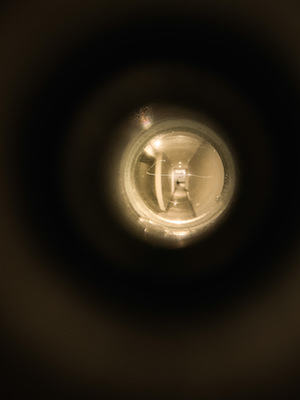
Peephole. Photo by Glendyn Ivin.
What are you up to these days? What can you tell us about your work during 2020 and coming up in 2021?
I finished Penguin Bloom a few months ago. We completed it mostly during the various lock downs but just in time before Stage 4 in Melbourne. Since then I’ve had my head down with commercials. I’m now back in Melbourne working on a commercial. Next year I’m embarking on a wonderful series, perhaps the biggest project I’ve undertaken. It will be shot right across Australia, and all going to plan we should be entering pre-production in January next year.
As a director with a feature film slated to come out in cinemas soon, how do you feel about the future of theatrical exhibition? Are we ever really going to go back to the movies?
It’s a really difficult time for cinemas for sure and I don’t want them to be a thing of the past. As much as I believe that television is the new cinema, especially as the expectations of audiences are so high plus we all generally have ‘big screens’ in our homes. But there is nothing better than sitting in the dark surrounded by strangers and you are all there ready to be taken somewhere emotionally. It’s so special. I made Penguin Bloom for a broad audience. I don’t call it a ‘family’ film but it’s a film you can take your family to. I want people to experience it in those big dark rooms with those huge screens. I’m hoping in a few months’ time we, in Australia at least, will feel comfortable in heading back into those dark rooms with the big screens!
Penguin Bloom is slated for release in January 2021 through Roadshow Films. You can follow @Glendyn_Ivin on Instagram or visit his website.
